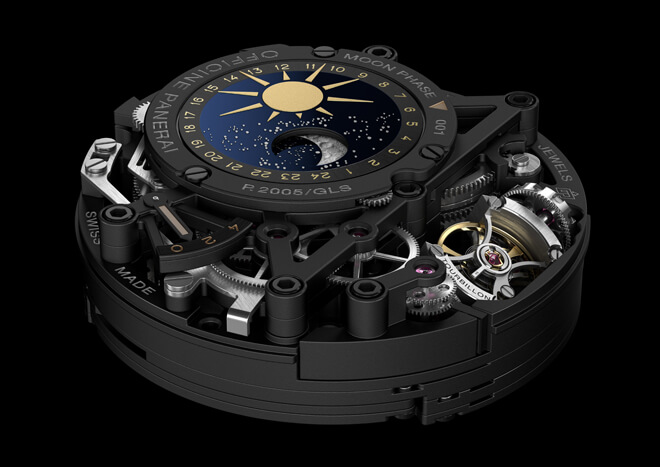SIHH 2018: Panerai L’Astronomo Luminor 1950, Panerai’s First Moonphase
Like its predecessor, the new L’Astronomo – Luminor 1950 Tourbillon Moon Phases Equation of Time GMT is made to order.

The last milestone for Officine Panerai was 2016’s superlative Radiomir 1940 Minute Repeater Carillon Tourbillon GMT. This year marked a new major milestone for the manufacture with the SIHH 2018 Panerai L’Astronomo Luminor 1950, Panerai’s first moonphase.
In Officine Panerai’s brand book, the manufacture often claims inspired muse from the works of fellow Italian, Galileo Galilei. Oddly, Galilei’s fascination with the skies never really translated into a astronomical novelty per se but fortuitously this all changed with the SIHH 2018 Panerai L’Astronomo Luminor 1950 Tourbillon Moon Phases Equation of Time GMT, a Panerai’s tribute packed with astronomical complications commemorating the 400th anniversary of the first observation of the sky by Galilei after the invention of the telescope.

SIHH 2018 Panerai L’Astronomo Luminor 1950, Panerai’s first moonphase
When study of the skies, a field almost as old as the story of mankind itself combines with classical watchmaking in the Panerai L’Astronomo, the resulting expression of high-end watchmaking is to be reckoned with. The Astronomo, an imaginatively named Luminor 1950 Tourbillon Moon Phases Equation of Time GMT is Officine Panerai’s first timepiece with a moonphase complication. L’Astronomo uses an innovative system of polarised crystals to indicate the date and intriguely, it’s not a limited production or series production piece but rather a new made-to-order Panerai Luminor which can be personalised to the owner’s home region.
While it is notable that this is Panerai’s first moonphase equipped watch, it would be a tragedy to not also call your attention to first use of the brand’s patented tourbillon regulator and a new date display, ingenious for using polarized crystals. The last time we saw a calendar of time complication combined with a tourbillon, it came in Panerai’s 2010 novelty, L’Astronomo, which featured a calendar and sunrise/sunset display; like the new SIHH 2018 Panerai L’Astronomo Luminor 1950 Tourbillon Moon Phases Equation of Time GMT, both pay homage to Galileo Galilei. All the features included in the 2010 L’Astronomo are present in 2018’s L’Astronomo, plus the GMT, moon-phase, and new date system, making it one the most function-packed Panerai high complications to date.

Like its predecessor, the new L’Astronomo – Luminor 1950 Tourbillon Moon Phases Equation of Time GMT is made to order, and the skeletonised movement, the P.2005/GLS (standing for Galileo Luna Scheletrato), is personalised to operate in accordance with the geographical coordinates of a place chosen by the client, this ensures that the moon-phase indication always corresponds to the precise phase of the moon over the owner’s geographic location.
It’s perhaps a point of intrigue that the moonphase is not prominently shown on the face of the SIHH 2018 Panerai L’Astronomo but it is also behooves us to mention that this isn’t your traditional moonphase. Located on the back of the movement, the Luminor 1950 Tourbillon Moon Phases Equation of Time GMT’s moonphase complication incorporates a day-night indicator composed of two superimposed disks that rotate in concert with each other.
The upper disc – which is read by a small external index fixed onto the movement – displays the 24 hours of the day, showing the sun during the hours of daylight and the stars of the sky at night. At the centre of the starry sky is a little round window through which the lower disc can be seen; on this appears the moon, its shape evolving day by day as a result of a small supplementary rotation of this disc of about 6.1° per day, a figure based on the exact duration of one lunar cycle (an average of 29 days, 12 hours, 44 minutes and 3 seconds). Thus, for such a precision moonphase display requiring adjustment only once every 122 years, it made sense to have it reflect the moon as precisely over his exact geographic location.
Like the moon phase indicator, the indicators of sunrise and sunset times are connected to home time and therefore, if the owner of the watch should find himself in a city with a different time zone from that of the chosen city, these indicators will continue to show the situation at the time at home, which is indicated by the GMT hand.
Finally, at six o’clock is the linear indicator of the equation of time, which displays the difference between actual time (solar time) and conventional time on each day, this period ranging between plus 15 minutes and minus 15 minutes, according to the time of year.
Caliber P.2005 Galileo Luna Scheletrato or P. 2005 GLS features Panerai’s patented tourbillon regulator system — visible from the front and back of the watch thanks to the skeletonization of the movement — while the rotation of the tourbillon differs from what one might see in a traditional tourbillon (it’s actually shares similarity with the escapement architecture like that of a Hautlence HL 2.0), the balance cage still rotates continuously on itself albeit in a perpendicular direction rather than parallel, canceling out any variations caused by gravity and possible shocks. Another point of difference is that the cage in Panerai’s system rotates every 30 seconds, rather than once per minute as in most other tourbillon escapement; the higher speed and the particular arrangement of the mechanism mean that any possible alterations of rate are effectively compensated, resulting in more accurate timekeeping.
Enhancing the skeletonised nature of the SIHH 2018 Panerai L’Astronomo Luminor 1950 Tourbillon Moon Phases Equation of Time GMT is the date disc designed to compensate a flaw in most other skeletonised watches – the date disc often obscures thorough view of the gearworks. The patent pending in-house Panerai date disc is made of borosilicate glass and the numbers of the days have laser-modified optical properties. The numbers are virtually invisible in all positions except for the one that is aligned with the little date window, where a further polarized crystal, situated above the date disc, causes the number to appear so that it is perfectly legible.
As a result, all the elements which would be found in a traditional dial appear on the movement or the flange, and the two spring barrels, which store enough power to last at least four days, are visible through the open back, which also enables the power reserve indicator mounted on the movement to be read.

Your own bespoke Panerai L’Astronomo Luminor 1950 Tourbillon Moon Phases Equation of Time GMT
As well as the technical personalisation of the P.2005/GLS movement, the new L’Astronomo – Luminor 1950 Tourbillon Moon Phases Equation of Time GMT also provides the opportunity of selecting the material and finish of the case, the colour of the hands and that of the Super- LumiNova® which makes the watch’s indications extremely readable even in the dark, as well as the colour of the alligator strap. In this way each client can create an individual watch of great character and elegance, for example choosing between a red gold or a white gold case, or the brushed titanium case of the basic version of the L’Astronomo for a more sporty and functional appearance.
2018 Panerai L’Astronomo Price and Specs
Naturally limited by production time
Case 50 mm brushed titanium with 100 metres water resistance
Movement Hand-wound mechanical P.2005/GLS calibre with 96 hours power reserve
Strap Black alligator leather strap
Price On request depending customisation










